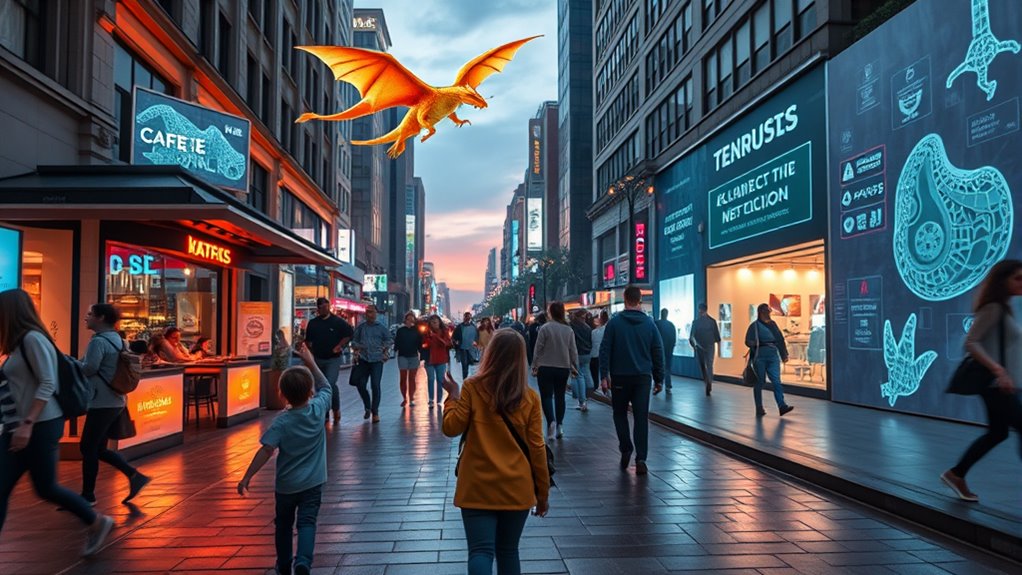Augmented reality (AR) is changing your everyday life by making daily tasks easier and more interactive. You can navigate with projected directions, shop by visualizing furniture in your space, and enhance your workouts with real-time feedback. AR also adds fun to social interactions through creative filters. This technology integrates seamlessly into your routine, making it more efficient and enjoyable. Discover the many ways AR can enrich your experiences even further.
Key Takeaways
- Augmented Reality enhances daily tasks by providing real-time weather updates and visual forecasts for better decision-making.
- In navigation, AR projects directions onto surroundings, making it safer and more intuitive for users.
- AR transforms shopping by allowing customers to visualize furniture and products in their own space before purchasing.
- Fitness experiences are enriched with AR, offering interactive workouts and real-time feedback to improve performance and motivation.
- Social interaction is elevated through AR filters on social media, adding fun and creativity to content creation and sharing.

As you go about your daily routine, you might not realize how often augmented reality (AR) enhances your life. It’s woven into the fabric of your daily experiences, making tasks easier and more engaging. From the moment you wake up to the time you go to bed, AR can subtly improve the way you interact with the world around you.
When you check your phone for the weather, you might not think about how AR features help visualize forecasts. Apps can overlay weather data on your screen, showing you real-time updates and projections. You can see how much it might rain later or the temperature in a graphical format, making it easier to decide what to wear.
AR features enhance your weather app experience, providing real-time updates and visual forecasts to help you dress appropriately.
As you navigate through your day, AR tools can transform your commute. If you’re using a navigation app, the AR feature can project directions onto your actual surroundings. Instead of just following a map, you see arrows guiding you through roads and streets, making the process more intuitive. This visual cue helps you focus on the road, ensuring you get to your destination safely.
Shopping is another area where AR makes a significant impact. When you’re trying to envision how a piece of furniture looks in your home, AR apps let you place virtual items in your real space. You can see how that new couch fits in your living room without needing to haul it home first. This technology saves you time and effort, ensuring you make informed decisions.
Even in fitness, AR has emerged as a valuable ally. Many workout apps use AR to create interactive experiences, guiding you through exercises while overlaying information about your form and technique. You can visualize your progress and receive real-time feedback, keeping you motivated and engaged.
Finally, consider how AR enhances your social experiences. When you use filters on social media, you’re engaging with AR. These filters can add fun elements to your photos and videos, allowing you to express yourself creatively. Whether it’s a whimsical animal filter or a stunning backdrop, AR adds a layer of excitement to your interactions.
In essence, augmented reality is quietly transforming your everyday life. From practical applications to entertaining experiences, it enhances your interactions with the world. As technology continues to evolve, you can expect AR to play an even bigger role in your daily routine, making life not just easier but also more enjoyable.
Frequently Asked Questions
What Devices Are Compatible With Augmented Reality Applications?
Smartphones and tablets are your best bet for augmented reality applications, especially those running on iOS or Android. Many newer models, like the iPhone and Samsung Galaxy series, support AR features. You can also use AR glasses, such as Microsoft HoloLens or Google Glass, for a more immersive experience. Gaming consoles, like the PlayStation with its PlayStation VR, can also offer AR capabilities. Just make sure your device’s software is updated!
Is Augmented Reality Safe for Children?
Yes, augmented reality can be safe for children, but it depends on the content and how it’s used. You should monitor the applications they access to make certain they’re age-appropriate. Encourage breaks to avoid eye strain and make sure they understand the importance of being aware of their surroundings while using AR. Setting limits on screen time can also help maintain a healthy balance between virtual experiences and real-world interactions.
How Does Augmented Reality Impact Mental Health?
Augmented reality can impact your mental health in both positive and negative ways. It can enhance social connections and provide immersive learning experiences, which might boost your mood and cognitive skills. However, excessive use can lead to feelings of isolation, distraction, or addiction, potentially worsening anxiety or depression. It’s essential to balance your AR experiences and stay aware of how they affect your well-being, ensuring they contribute positively to your life.
Can Augmented Reality Be Used in Education?
Absolutely, augmented reality can transform education into a vivid, interactive adventure. Imagine stepping into a history lesson where ancient civilizations come alive around you! It enhances learning by making complex concepts tangible, allowing you to visualize and interact with subjects like never before. You can explore the solar system from your classroom or dissect a virtual frog without the mess. This immersive experience not only makes learning fun but also deepens your understanding and retention.
What Are the Privacy Concerns With Augmented Reality Technology?
Privacy concerns with augmented reality technology mainly revolve around data collection and surveillance. You might worry about how your personal information, including location and interactions, gets tracked and stored. There’s also the risk of unauthorized access to sensitive data, which can lead to identity theft. Additionally, as AR devices capture real-world images, the potential for invading others’ privacy increases, making it essential to understand and manage these risks effectively.
Conclusion
As you embrace augmented reality in your everyday life, consider this: a recent study found that 75% of people using AR technology reported feeling more engaged with their surroundings. Imagine enhancing your shopping experience, exploring unfamiliar places, or even learning new skills with just a tap on your device. AR isn’t just a futuristic concept; it’s transforming how we interact with the world around us. So, why not plunge in and see how it can enrich your daily activities?









